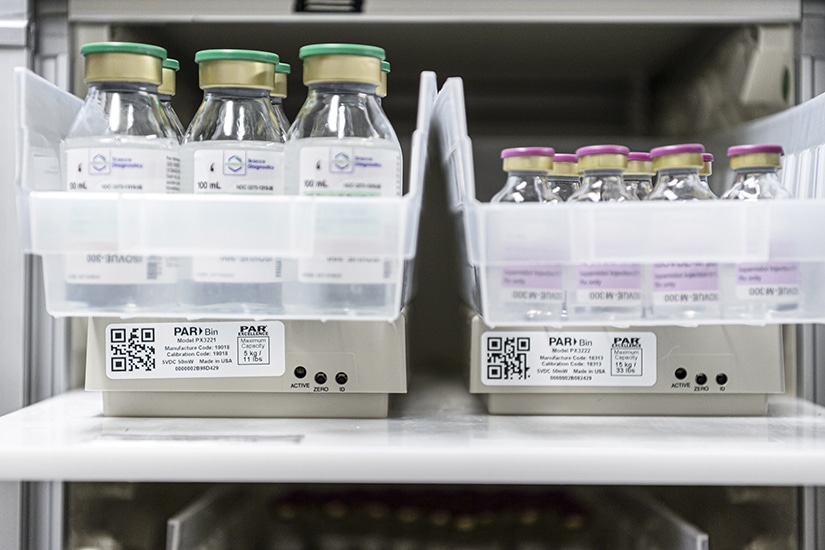|
Getting your Trinity Audio player ready...
|
With almost twenty years of experience in the healthcare supply chain space, Thad MacKrell has witnessed numerous advancements to healthcare software applications, service models, and technology. During this time, MacKrell gathered experience from companies across the United States and parts of Europe, most recently discovering an opportunity with PAR Excellence Systems—a role, he says, that he couldn’t pass up.
“The two things that I found most attractive about PAR was its ‘A-list’ client roster and its product offering, a combination of software and unique hardware,” MacKrell says. PAR’s inventory management hardware offering provides hospital systems with the means to allow caregivers to work more efficiently and, in turn, increases the quality of patient care.
While hospitals have embraced many types of automation in departments like food/nutrition, pharmacy, laboratory, and laundry, by far the most common method of managing inventory in hospitals today is as manual as it was twenty years ago: dispatching a person with a barcode scanner to check supply levels. On any given morning, a supply clerk might cover between ten and twelve locations across a hospital, with each location containing 150 to 300 SKUs. The problem with this approach, however, is evident in the numbers: labor is expensive, and the data collected is unreliable.
“The tech is eyeballing hundreds of bins in just a few minutes and making spot decisions based on gut feeling, mood, or the day of the week,” he explains. “What if they forget to look behind the door or get distracted helping a nurse?”

Midday stock outs, or out-of-stock events, result in call downs from nursing, which are hugely disruptive to both patient care and supply chain staff and negatively impact patient safety.
“The net result is that hospitals are chronically overstocked and clinical staff lose confidence in the supply chain.” MacKrell says.
But the problem isn’t just that the daily inventory data gathering is laborious, haphazard, and nonstandard, according to MacKrell. The industry is also recognizing that macrotrends are irreversibly in favor of automation: labor costs, training, turnover, and service quality expectations are all increasing.
PAR specializes in creating and providing fully automated scales that weigh products stocked in hospital inventory locations (think gloves, gowns, gauze, and drapes but also pharmaceuticals and even linens). As clinical staff consume supplies, the weight changes, and each scale tracks the on-hand balance, allowing PAR’s software to calculate reorder quantities automatically.
When the scales are first installed, technicians set an ideal level (the “par level”) and a reorder point. As the inventory gets lighter, the product gets reordered. When a caregiver takes even a single suture from a PAR scale, for instance, the system recognizes the difference. Take enough sutures, and a reorder threshold is reached, at which point PAR’s software automatically compiles a requisition for more of that suture SKU. Everything about PAR’s system is automated, meaning the days of walking around with a bar code scanner to “eyeball” supply locations are over.
“You’re taking the labor you do have and giving them information to allow them to work smarter.”
“The difference is that our product doesn’t require the caregiver or the supply chain staff to do anything to prepare a requisition: clinical staff just take the product and go, and PAR’s weighted bins continuously measure the level of inventory in real time,” says MacKrell.
With PAR’s technology, supply chain staff can be redirected to inventory optimization and addressing product backorders, allocations, conversions, and the need for more detailed analytics. Moreover, the cost of capital is very low, especially compared to the costs attached to recruiting and training. Investing in a solution like PAR with an expected life of more than fifteen years appeals to CFOs and logistics professionals.
“This is not a labor-loss model,” MacKrell says. “You’re taking the labor you do have and giving them information to allow them to work smarter. PAR creates capacity in the workload so you’re able to redeploy your people and figure out how to do more with less.”
While the original concept of the scales has revolutionized supply chain management as a whole, PAR hasn’t stopped there. Newer models of PAR’s products are aimed at reducing waste, making orders more sustainable and reliable, and enhancing customer care. The company has considered these factors from all angles.
Firstly, MacKrell explains the importance of first in, first out (FIFO), an inventory rotation strategy that ensures products that are stocked first are used first. With items like sutures and IV fluids, for example, FIFO lends itself to using supplies prior to their expiration date. As such, PAR has adapted the design of its bins to ensure FIFO management of inventory whenever possible.

“We’ve redesigned our suture bins, for example, so that technicians load them at the top and nurses take from the bottom,” MacKrell explains. “If we keep piling new items on top of the old, we end up throwing things away. We’re seeking to avoid that.”
This process not only ensures that less product is wasted, but also enables better ordering processes. MacKrell says PAR supports this goal by “running inventory leaner,” stocking less of everything while systematically issuing more consistent orders.
“It’s like a 3-D math problem, working out what space you have and what you need to order so we can take costs out of the system while reducing the amount of storage space required,” MacKrell says.
PAR’s technology investment is also directed at clinical satisfaction, as demonstrated by their recent integration of their scales with Amazon’s Alexa. “We’ve made it possible for a nurse to simply ask the room a question instead of calling supply chain for help,” MacKrell explains. “They can ask questions like ‘Is our order en route?’ or ‘Where’s the nearest storeroom with more than five of item XYZ?’ and Alexa will respond with the appropriate answer.”
“PAR’s technology is a natural extension of healthcare’s trend towards automation,” MacKrell says. “We’re revolutionizing the market by doing what it requires. We’re making it automated. We’re improving satisfaction, improving patient care, and reducing inventory to save space and labor. When clinical staff have what they need, they’re more satisfied and their confidence grows, patient care is improved, and limited supply chain resources can be directed toward higher-value activities.”

